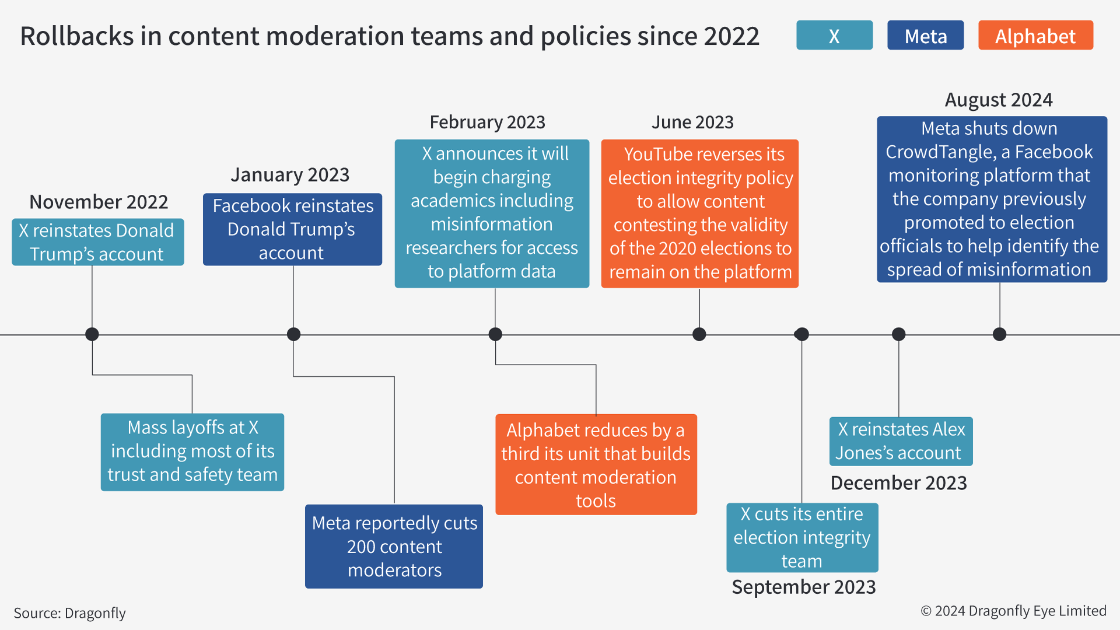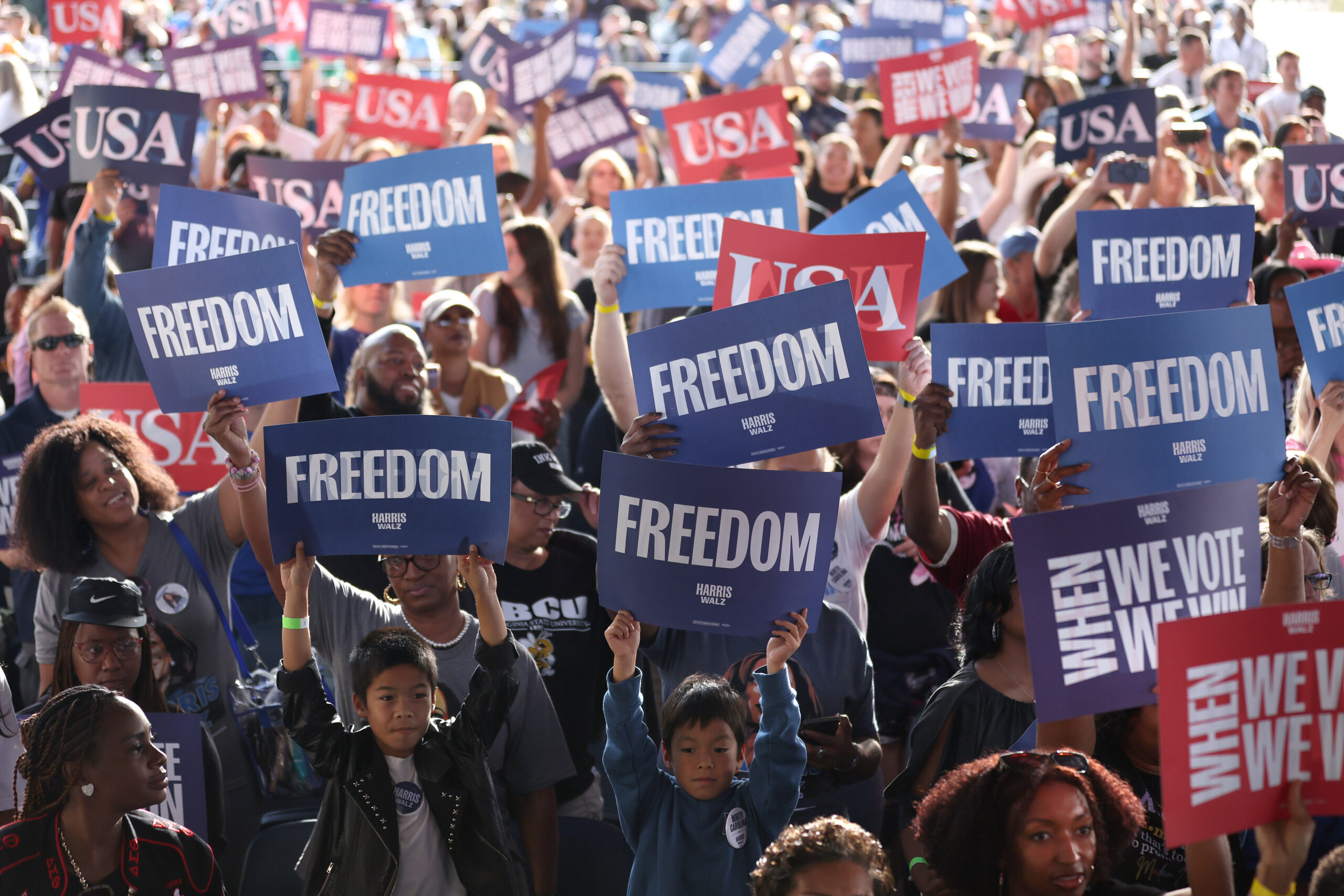Hostile foreign states will almost certainly continue mounting disinformation campaigns until Inauguration Day (20 January) at least
This assessment was issued to clients of Dragonfly’s Security Intelligence & Analysis Service (SIAS) on 31 October 2024.
- US officials recently identified that the most likely source of violence between the election and inauguration is from domestic extremists with grievances rooted in conspiracy theories
- Protests, harassment and isolated acts of violence against election officials or organisations associated with migrants prompted by election-rigging rumours are highly probable after 5 November
Influence campaigns targeting the US public around the general elections on 5 November are likely to fuel protests and localised unrest in the days after. This would include demonstrations outside vote-counting centres, in-person harassment of officials and isolated acts of violence. Much disinformation originates domestically, but hostile foreign states, especially Russia and Iran, are highly motivated to push divisive narratives to destabilise the US internally after polls close. Disinformation alone will probably not directly incite violence but would plausibly boost attendance at protests.
It is unlikely, in our view, that influence campaigns will trigger widespread and coordinated partisan violence such as on 6 January 2020 (see B-USA-02-10-24 for more). That incident aside, the police and security services have maintained order, and election officials seem better prepared to counter disinformation than in previous years. But they face more challenging conditions due to cutbacks on content moderation by major social media platforms. The midterm elections in November 2022 took place largely peacefully, despite intense disinformation campaigns leading up to the vote.
Widespread conspiracy theories of a rigged election
Various conspiracy theories about a rigged election have been circulating on fringe political forums for several months at least. Some of these have already been shared by foreign disinformation networks, according to reports from US intelligence agencies and cybersecurity companies. We have seen two prominent examples of such narratives emerge on far-right Telegram channels and online forums in recent months:
- Large numbers of illegal migrants plan to vote Democrat and skew the results of the election
- The Democratic Party is planning widespread voter fraud by mailing in fraudulent absentee ballots
Hostile foreign states and domestic extremist groups will almost certainly continue trying to amplify these narratives. In addition to re-sharing content, this would also plausibly include falsifying evidence of election rigging. Probable tactics would involve creating deepfakes of, for instance, election officials stuffing ballot boxes, and spoofing legitimate news outlets with fake headlines.
Electoral fraud rumours likely to stoke unrest
Rumours around election rigging are likely to drive protests or localised unrest in the days following 5 November. In addition to protests, this would probably include harassment of election officials (such as death threats and swatting – hoax 911 calls reporting a crime at a target’s house) and scuffles between groups of protesters. The Justice Department published an advisory on 24 October warning of threats to election workers following multiple cases of death threats recently made against them.
Most publicly available polls project that the presidential race will be very close. And the tallying process in some swing states appears likely to take several days at least. In 2020, it took five days for some states to report a winner. Such a delay in the announcement of results would give more time for speculation on election rigging to circulate widely and for disinformation to intensify. Protests and harassment are most likely to occur in swing states and highly contentious races.
Protests over alleged electoral fraud would be likely to take place near government buildings, the offices of major news outlets, and organisations associated with migrants. This would include migration NGOs, federal judges and border security personnel. Protests around the 2020 election and recent calls for violence against migrants on extremist forums suggest these will be the most likely targets. Some far-right sympathisers on fringe political forums seem particularly concerned that migrants will illegally vote and rig the election for the Democrats this year.
Left-wing disinformation exists but is less entrenched
Hostile foreign states will probably amplify some left-wing disinformation but remain largely focused on right-leaning audiences. We have seen some examples of disinformation in left-wing spaces, such as allegations that the attempted assassination of Trump in July was staged. But left-leaning conspiracies are not as entrenched as those on the right, according to misinformation researchers. And we have not seen many calls for election-related violence in such discussions. Recent cases of Russian disinformation identified in a Recorded Future report last week mainly shared content aligning with conspiratorial views of far-right sympathisers.
Months-long disinformation campaigns from hostile states ahead
Hostile foreign states, especially Russia, China and Iran, are almost certain to continue conducting disinformation campaigns after 5 November until at least Inauguration Day (20 January 2025). Their aims are to reduce public trust in government and foment civil unrest, according to US security agencies.
The days after the election are likely to be especially tense politically, which we anticipate these countries will seek to take advantage of. We continue to assess that large protests of tens of thousands of people are probable regardless of who wins the presidential race (see B-USA-12-09-24 for our protest outlook around the election).
We anticipate that foreign-enabled disinformation campaigns will be more intense this year compared with 2020. US intelligence officials said in a report declassified on 22 October that Russia, China and Iran are prepared to exploit opportunities to exert influence. These countries now have several years of experience identifying divisive narratives and conducting such campaigns at pace and scale towards target audiences. Officials said that they expect that Russia in particular intends to incite violence, especially if Trump loses to Harris.

Post-election disinformation will probably spread more widely than after the 2020 election. Several social media companies have reduced their content moderation and loosened election integrity policies since 2020. One example is the reinstatement of accounts belonging to prominent far-right figures like media personality Alex Jones. Jones was banned by Twitter in 2018 for ‘abusive behaviour’. A March 2021 study by the Stanford Internet Observatory found that a handful of ‘super-spreader’ accounts (including those of Trump’s two eldest sons) shared the most popular election-related misinformation leading up to the 6 January storming of the Capitol.
Coordinated cyberattacks against information sources
There is a good chance that hostile foreign actors would use cyberattacks alongside other online influence activities to fuel speculation about a rigged election. These are most likely to include website defacement or DDoS attacks against government, news or polling prediction sites. Many Russian and Iranian hacktivist groups frequently conduct ideologically motivated DDoS attacks and the US elections are almost certain to be a key target. Such incidents would generally be resolved within hours, but still fuel claims of election rigging by causing people to suspect interference.
Potential targets of election violence can change quickly
The potential targets of post-election violence are liable to change in a matter of days. This is because disinformation networks tend to work very opportunistically to exploit narratives that are rapidly gaining traction online. We observed this during the anti-immigration riots in the UK in July. The content shared by key personalities who are popular among far-right sympathisers (such as Alex Jones or Elon Musk) will probably be a good indicator of the types of narratives that are being widely spread and resonating with activists.
Image: Supporters hold signs as Democratic presidential nominee, U.S. Vice President Kamala Harris, speaks during a campaign rally at the PNC Music Pavilion. With only days to go until Election Day, Vice President Kamala Harris is campaigning in Georgia and North Carolina. On 02 November 2024, in Charlotte, North Carolina. Photo by Justin Sullivan/Getty Images.



